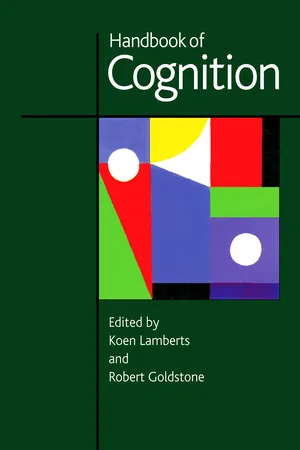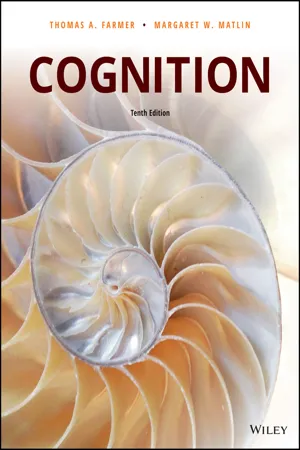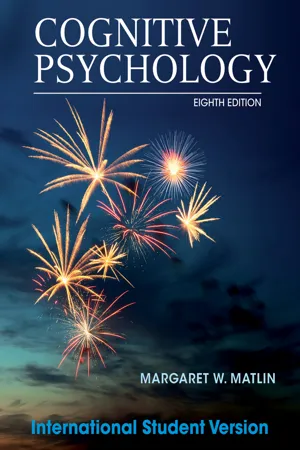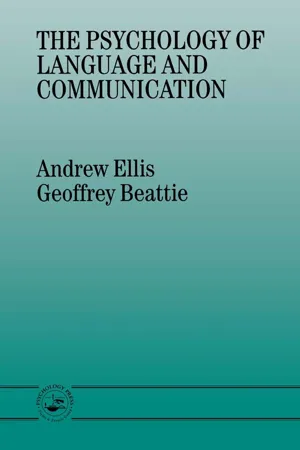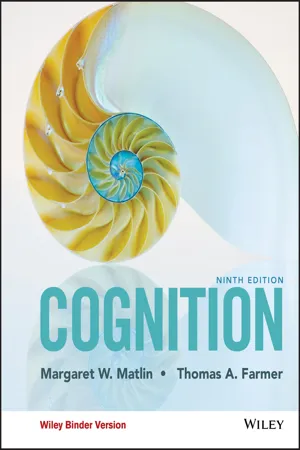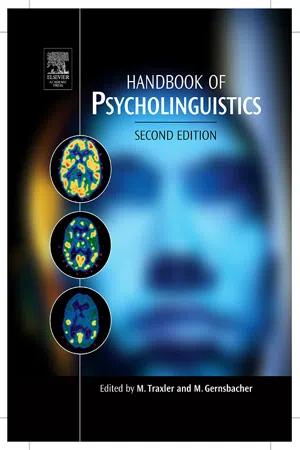Languages & Linguistics
Language Comprehension
Language comprehension refers to the ability to understand and interpret spoken or written language. It involves processing linguistic input, extracting meaning, and making sense of the information conveyed. This cognitive process encompasses various skills such as vocabulary knowledge, grammar understanding, and the ability to infer meaning from context.
Written by Perlego with AI-assistance
Related key terms
1 of 5
8 Key excerpts on "Language Comprehension"
- eBook - PDF
- Koen Lamberts, Rob Goldstone, Koen Lamberts, Rob Goldstone(Authors)
- 2004(Publication Date)
- SAGE Publications Ltd(Publisher)
Language permeates our lives. For most people, on most days, Language Comprehension and language production are central activities, not only because of the time they occupy, but also because of the role they play in people’s lives. For the most part we take our linguistic abilities for granted, though they may come to our attention when we encounter a word whose meaning we do not know or, more seriously, when we hear, or attempt to learn, a language with which we are not familiar. Indeed, people often show a remarkable lack of curiosity about the mental representations, mechanisms and processes that underlie their linguistic abilities. This chapter details some of the mental capacities on which the ability to understand language is based. For more detailed information about spe-cific aspects of comprehension, see the following chapters by McQueen and by Pollatsek and Rayner. For ordinary language users, comprehension is either listening or reading. Listening is the more basic form of comprehension. It is both phylogenet-ically and ontogenetically prior to reading, and it does not have to be taught. There are many special questions about reading, which are addressed in Chapter 12 by Pollatsek and Rayner. However, many of the processes of comprehension are assumed to be common to listening and reading, and much of the work reported in this chapter has used visual materials. Comprehension is a process that unfolds in time. Speech is inherently temporal. Written and printed material is read in a sequential manner (see Pollatsek & Rayner, Chapter 12, this volume). Not only that, but as we shall see, there is no simple single process of comprehension that is applied to each part of a text or discourse, but rather a series of processes that themselves unfold through time and become less specifically tied to individual parts of the text. Traditionally (e.g. Forster, 1979) these processes are divided into three groups: lexical, syntactic and discourse (message) level. - eBook - PDF
- Thomas A. Farmer, Margaret W. Matlin(Authors)
- 2019(Publication Date)
- Wiley(Publisher)
However, older children, teenagers, and adults can think about their reading and listening strate- gies (Lynch, 2010). For instance, when you read a book, you know that you should think about your relevant background knowledge. In addition, you consider whether you should read every sentence or else skim through the details. You also know that you should monitor whether you understand the material you have just read (Griffith & Ruan, 2005; Perfetti et al., 2005). Furthermore, you sometimes become aware that your mind has wandered away from the material you are reading (Smallwood & Schooler, 2006). In the past, educators seldom trained students to develop their metacomprehension skills (Randi et al., 2005). However, educators are currently developing some helpful strategies. For instance, teachers can instruct students in middle school to think out loud, so that they can summarize passages, make predictions about possible outcomes, and describe puzzling sections (Israel & Massey, 2005; Schreiber, 2005; Wolfe & Goldman, 2005). LANGUAGE I: INTRODUCTION TO LANGUAGE AND Language Comprehension 212 S E C T I O N S U M M A RY P O I N T S Overview of Psycholinguistics 1. Psycholinguistics is the study of the cognitive processes involved in language production, Language Comprehension, and naturalistic communication; it is a large and interdisciplinary field. 2. Some of the central concepts in psycholinguistics are the phoneme, the morpheme, morphology, syntax, grammar, semantics, semantic memory, and pragmatics. 3. Many cognitive processes operate simultaneously and in tight-knit coordination during language use; visual and auditory processes, attention, working memory, long-term memory, and mental imagery are all necessary components of language processing. 4. According to Noam Chomsky, (a) language skills are innate in humans, (b) language is separate from other cognitive processes, and (c) the deep structure of a sentence captures its core meaning. - eBook - PDF
- Margaret W. Matlin(Author)
- 2014(Publication Date)
- Wiley(Publisher)
C H A P T E R 9 Comprehending Language Chapter Introduction The Nature of Language A Caution: Psycholinguistics Is English-Centered A Brief History of Psycholinguistics Factors Affecting Comprehension The ‘‘Good-Enough’’ Approach to Language Comprehension In Depth: Neurolinguistics Basic Reading Processes Comparing Written and Spoken Language Reading Words: Theoretical Approaches Implications for Teaching Reading to Children Understanding Discourse Forming an Integrated Representation of the Text Drawing Inferences During Reading Teaching Metacomprehension Skills Individual Differences: Distracting Speech and Reading Comprehension Language Comprehension and Latent Semantic Analysis 295 P R E V I E W Chapters 9 and 10 examine how we process language. Specifically, Chapter 9 empha- sizes Language Comprehension in the form of listening and reading. In contrast, Chapter 10 will emphasize language production (speaking and writing), as well as bilingualism—a topic that encompasses both Language Comprehension and language production. We’ll begin Chapter 9 by exploring the nature of language. As it happens, most of the research in psycholinguistics studies English speakers and readers. In this first section, we’ll look at the structure of language, a brief history of psycholinguistics, and several factors that influence comprehension. In addition, we will discuss how people may not manage to comprehend every component of the language they hear or read; instead, they manage to acquire a ‘‘good enough’’ understanding. Our final topic in this section is the in-depth discussion of neuroscience research on language. Next, we’ll examine basic reading processes, beginning with a comparison of written and spoken language. This section also examines some theoretical approaches to word recognition. In addition, we’ll consider some implications for teaching reading; teachers face an especially challenging task, given the irregularities of the English language. - eBook - ePub
- Geoffrey Beattie, Andrew Ellis(Authors)
- 2014(Publication Date)
- Psychology Press(Publisher)
13 Language Comprehensionand memoryWe began this book by defining communication in Chapter 1 as the encoding of a message by one organism into a physical signal which passes to another organism who decodes the signal in order to recreate the original message. We have since noted how human beings employ not one but several channels of communication or ‘signal systems’, such as facial expressions, gestures, eye contact, speech etc. Chapter 7 was concerned with the encoding of a message into just one of those channels, namely speech. We saw then how speech planning involves linguistic units of different sizes, ranging from admittedly rather ill-defined ‘idea units’, through sentences, clauses, words and morphemes, to phonemes or letters. Evidence from slips of the tongue, pauses and other sources suggested that all of these units have ‘psychological reality’ as far as speech production is concerned.In the previous chapter we looked at the parts played by phonemes, letters, morphemes and words in language reception (listening and reading). It should not surprise us that these units of planning also turned out to have a role in perception: that which is a unit of encoding is also likely to be a unit of decoding. In this chapter we turn to a consideration of the processes involved in comprehending clauses, sentences, and text.Throughout this book we have tried to emphasize that the natural use of language, for which our cognitive processes are most likely to be adapted, is conversational give-and-take. Sadly, very little research has been done on either the production or comprehension of speech in conversational settings. In a typical Language Comprehension experiment a ‘subject’ (volunteer) sits in silence reading a passage of text, or listening to one through headphones. The subject's task might be to press a button when a specified target word occurs, or to recall parts of the text later (note our comment in Chapter 1 that communication only requires the decoder to have a potential - eBook - PDF
- Margaret W. Matlin, Thomas A. Farmer(Authors)
- 2016(Publication Date)
- Wiley(Publisher)
b) The phonics approach has yielded very unimpressive results, and the whole- language approach is clearly the only approach to use. Discourse comprehension 353 We began this chapter with an overview of the nature of language; that overview con- sidered both linguistic theory and the biological basis of language. Then we explored basic reading processes. You’ll notice that all these topics focus on the way we process small units of language, such as a phoneme, a letter, a word, or an isolated sentence. In your daily life, however, you are continually processing discourse, that is, inter- related units of language that are larger than a sentence (Traxler, 2012; Treiman et al., 2003). You listen to the news on the radio, you hear a friend telling a story, you follow the instructions for assembling a bookcase…and you read your cognitive psychology textbook. In Chapter 8, we considered Bartlett’s (1932) research, which focused on these larger linguistic units. Speciically, Bartlett demonstrated that people’s recall of stories becomes more consistent with their schemas after a long delay. However, for the next four decades, psychologists and linguists primarily studied words and isolated sen- tences. In fact, the topic of discourse processing was not revived until the mid-1970s (Graesser et al., 2003). Fortunately, research on discourse comprehension is now an active topic in psycholinguistics (Lynch, 2010; Traxler, 2012). So far in this chapter, we’ve emphasized how context can help us understand sounds, letters, and words. Now we’ll see that context also helps us comprehend larger linguistic units. As Chapter 8 pointed out, general background knowledge and expertise help to facilitate our conceptual understanding. Research on discourse comprehension also emphasizes the importance of scripts, schemas, and expertise (e.g., Harley, 2008; Mayer, 2004; Zwaan & Rapp, 2006). At all levels of Language Comprehension, we see additional evidence of Theme 5. - eBook - ePub
Teaching Foreign Language Skills
Second Edition
- Wilga M. Rivers(Author)
- 2018(Publication Date)
- University of Chicago Press(Publisher)
6 Listening ComprehensionSpeaking does not of itself constitute communication unless what is being said is comprehended by another person. The greatest difficulty for travelers in strange countries is not primarily that they cannot make themselves understood; this they can frequently do by gesture, by writing, or by pointing to something written in a bilingual book of phrases. Their major difficulty, and one that leads to considerable emotional embarrassment, is that they cannot understand what is being said to them and around them. Even if the native speaker enunciates the words slowly and distinctly, elements of stress, intonation, and word grouping (often exaggerated in an earnest attempt at clarity) add to the confusion of the inexperienced foreigner. As a result, there is no communication, and the traveler’s speaking skills cannot be exercised to great advantage. Enjoyment of and participation in community life and thought are further curtailed by inability to comprehend announcements, broadcasts, lectures, plays, and films.Teaching the comprehension of spoken language is of primary importance if the communication aim is to be achieved. A frequently neglected area, listening comprehension has its peculiar problems which arise from the fleeting, immaterial nature of spoken utterances and the complicated ways we process what we hear.THEORETICAL CONCEPTS BASIC TO LISTENING COMPREHENSIONIn chapter 5 , the special problems of discrimination of sounds, stress, and intonation are discussed, but these are only a few of the elements involved in understanding what is being said to us.Information TheoryUseful ideas for teaching listening comprehension can be drawn from the research of communications engineers concerned with the maximum efficiency of telephonic and telegraphic equipment. Their work has dealt particularly with the nature of the message to be communicated, the qualities of the channel by which it passes from emitter to receiver, and the state in which it is received and interpreted by the listener.1 We are not concerned here with detailed mathematical explanations of information theory, which had a profound influence on psychological research in the sixties, but rather the lines of thought that can be extracted from it for the teacher. (Information theory should not be confused with information processing, which is the term used for the activity of the mind in extracting, processing, storing, and retrieving the meaning of verbal and nonverbal material. This concept, which is basic to much contemporary research in perception, artificial intelligence, and cognition, is discussed later in this chapter.)2 - eBook - PDF
- Matthew Traxler, Morton Ann Gernsbacher(Authors)
- 2011(Publication Date)
- Academic Press(Publisher)
Studies of the role of language context in comprehension have also undergone a significant shift over the years. Research in the two-stage era focused on the use of real-world knowledge in guiding the comprehension process, and on the difficulties inherent in accessing relevant information online (Kintsch & Van Dijk, 1978). People know a vast amount about the world; as research on natural language processing in artificial intelligence suggested, it is a difficult problem to design a comprehension system that accesses relevant information from an enormous database of facts (Hayes-Roth & Jacobstein, 1994). Moreover, several studies emphasized the ineffectiveness of context, suggesting that comprehenders were limited in their application of real-world knowledge during comprehension (Forster, 1979), that context facilitated lexical processing only when words were highly predictable (Fischler & Bloom, 1979), and that this very strong degree of contextual constraint is rare in naturally occurring texts (Gough, Alford, & Holly-Wilcox, 1981). These results led to the conclusion that context-based prediction was not an important component of comprehension. Complementary findings emerged from the study of lexical ambiguity resolution (e.g., Swinney, 1979; Tanenhaus et al., 1979). Many words are ambiguous between semantically distinct meanings (e.g., WATCH: a timepiece, to look; BANK: a monetary institution, the ground bordering a river). These early studies examined the processing of ambiguous words for which there are two main meanings that are used approximately equally often in the language (“equibiased” ambiguities). The main find-ing was that subjects initially activated multiple meanings, even in contexts that were highly disambiguating. For example, the contexts in (1) and (2) clearly disambiguate the word ROSE. - eBook - ePub
- François Grosjean, Ping Li(Authors)
- 2012(Publication Date)
- Wiley-Blackwell(Publisher)
I Spoken Language ProcessingPassage contains an image Chapter 2 Speech Perception and Comprehension François Grosjean
Even though there are many more bilinguals in the world who listen to two or more languages than read them (recall that many bilinguals may not know how to read and write one of their languages), the studies pertaining to bilingual speech perception and comprehension have been less numerous than those pertaining to reading (see Chapter 4). The situation is changing, however, and it is now possible to give an overview of how bilinguals perceive and comprehend their different languages.This chapter has several aims. The first is to describe how bilinguals process just one language when there are no elements of the other language(s) in it – we call this “monolingual speech.” Bilinguals have to deal with it in their everyday lives when they are in a monolingual mode (see Chapter 1), and it is important that we understand how they do so.The second aim is to describe how bilinguals process bilingual speech, that is, speech that contains code-switches and/or borrowings. As we saw in Chapter 1, bilinguals in a bilingual mode often bring in the other language, and it is worth asking how listeners process both the base language – the main language being heard – as well as the guest elements of the other language.A third aim will be to introduce readers to the methodology used to study oral language perception and comprehension in bilinguals. Unlike with speech production, where we can learn a lot about the underlying production mechanisms involved from the speech produced, with speech perception and comprehension this is not possible. We therefore have to resort to experimental paradigms to “open a window” into the mind of the bilingual listener.This chapter contains three sections. In the first, we offer a rapid overview of how speech perception and comprehension takes place. We will end the section with a short discussion of the ways in which bilinguals are invariably different from monolinguals when doing this type of processing. In the second section, we will examine two aspects related to how bilinguals process monolingual speech. The first relates to the activation of the other language, that is, the language not being heard. In essence, does that other language play a role and, if so, when and how? We will see that the selective/nonselective processing issue already discussed in Chapter 1, Section 1.4 is far more subtle than was thought at first and that the answer is less categorical than many have believed. The second aspect will concern the more permanent influence of the other language on processing. This pertains primarily to how the dominant language may influence the processing of the nondominant (weaker) language. Finally, the third section of this chapter will examine how speech that contains code-switches and/or borrowings is processed by bilinguals. Much less is known about this but what we do know is fascinating and well worth a description.
Index pages curate the most relevant extracts from our library of academic textbooks. They’ve been created using an in-house natural language model (NLM), each adding context and meaning to key research topics.
